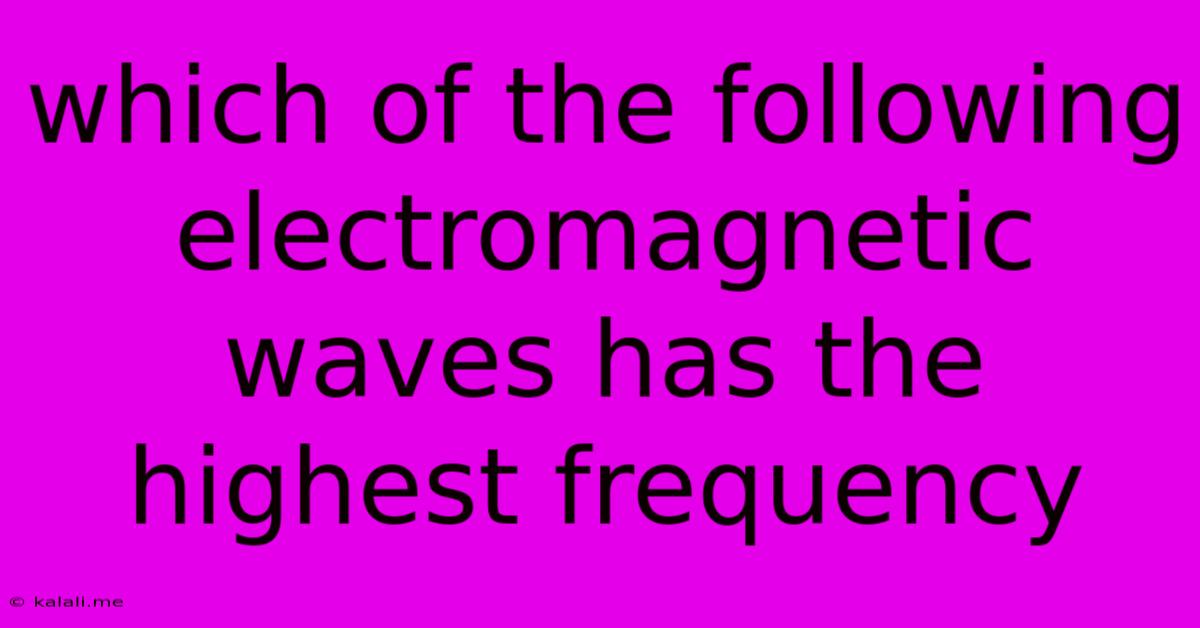Which Of The Following Electromagnetic Waves Has The Highest Frequency
Kalali
Jun 13, 2025 · 3 min read

Table of Contents
Which Electromagnetic Wave Has the Highest Frequency? Understanding the Electromagnetic Spectrum
The electromagnetic (EM) spectrum is a vast range of electromagnetic radiation, spanning from extremely long wavelengths to incredibly short ones. This spectrum encompasses various types of waves, each characterized by its unique frequency and wavelength. But which of these waves boasts the highest frequency? This article will explore the EM spectrum and definitively answer this question. We'll also delve into the relationship between frequency, wavelength, and energy.
The electromagnetic spectrum, ordered from lowest to highest frequency, includes: radio waves, microwaves, infrared radiation, visible light, ultraviolet radiation, X-rays, and gamma rays. The frequency is directly proportional to energy and inversely proportional to wavelength. This means that waves with shorter wavelengths have higher frequencies and higher energy levels.
Understanding Frequency and Wavelength
Before diving into which EM wave has the highest frequency, let's clarify these key concepts:
-
Frequency: This refers to the number of wave cycles that pass a fixed point per unit of time, typically measured in Hertz (Hz). A higher frequency means more cycles pass per second.
-
Wavelength: This is the distance between two consecutive crests (or troughs) of a wave. Wavelength is usually measured in meters (m) or nanometers (nm).
The relationship between frequency (f), wavelength (λ), and the speed of light (c) is given by the equation: c = fλ. Since the speed of light is constant, a shorter wavelength implies a higher frequency, and vice versa.
Gamma Rays: The Highest Frequency Champions
Of all the electromagnetic waves, gamma rays possess the highest frequency and, consequently, the shortest wavelength and highest energy. They are produced by some of the most energetic processes in the universe, including nuclear reactions, supernova explosions, and radioactive decay.
While other types of electromagnetic radiation, such as X-rays, have very high frequencies, gamma rays consistently outpace them in terms of frequency. The frequency of gamma rays ranges from approximately 10<sup>19</sup> Hz to over 10<sup>24</sup> Hz, far exceeding the frequencies of all other electromagnetic waves.
The Electromagnetic Spectrum Hierarchy: A Recap
Here's a quick summary of the electromagnetic spectrum ordered by increasing frequency:
- Radio Waves: Lowest frequency, longest wavelength. Used in communication technologies.
- Microwaves: Used in ovens and radar systems.
- Infrared Radiation: Associated with heat; felt as warmth.
- Visible Light: The only part of the EM spectrum visible to the human eye. Consists of colors ranging from red (lowest frequency) to violet (highest frequency).
- Ultraviolet (UV) Radiation: Can cause sunburn; used in sterilization techniques.
- X-rays: Used in medical imaging and material analysis.
- Gamma Rays: Highest frequency, shortest wavelength, and highest energy. Extremely penetrating.
Conclusion: Gamma Rays Reign Supreme
In conclusion, gamma rays hold the title of possessing the highest frequency within the electromagnetic spectrum. Their extremely high energy and short wavelengths make them a powerful force in the universe, and understanding their properties is crucial in various scientific fields. Remember, frequency, wavelength, and energy are intrinsically linked – a higher frequency always means a shorter wavelength and higher energy in the context of electromagnetic radiation.
Latest Posts
Latest Posts
-
How Is Monopolistic Competition Similar To Perfect Competition
Jun 14, 2025
-
Correct The Following Sentences With Answers
Jun 14, 2025
-
Which Of The Following Is Not A Correctly Matched Pair
Jun 14, 2025
-
The Direction Of Natural Processes Is From States Of
Jun 14, 2025
-
What Is The Least Common Multiple Of 12 And 22
Jun 14, 2025
Related Post
Thank you for visiting our website which covers about Which Of The Following Electromagnetic Waves Has The Highest Frequency . We hope the information provided has been useful to you. Feel free to contact us if you have any questions or need further assistance. See you next time and don't miss to bookmark.